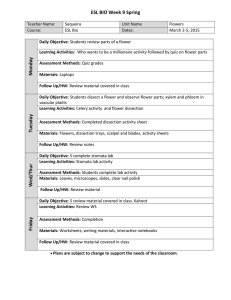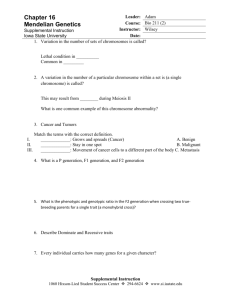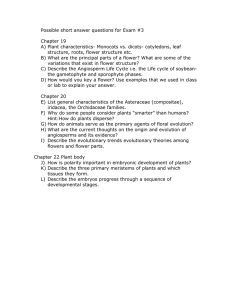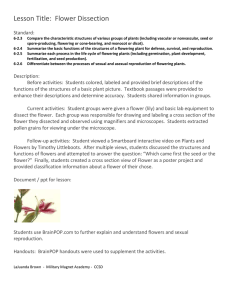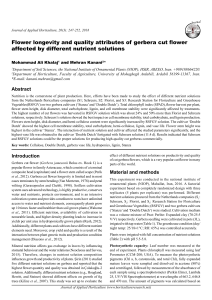Gerbera Daisy Dr. Terri W. Starman
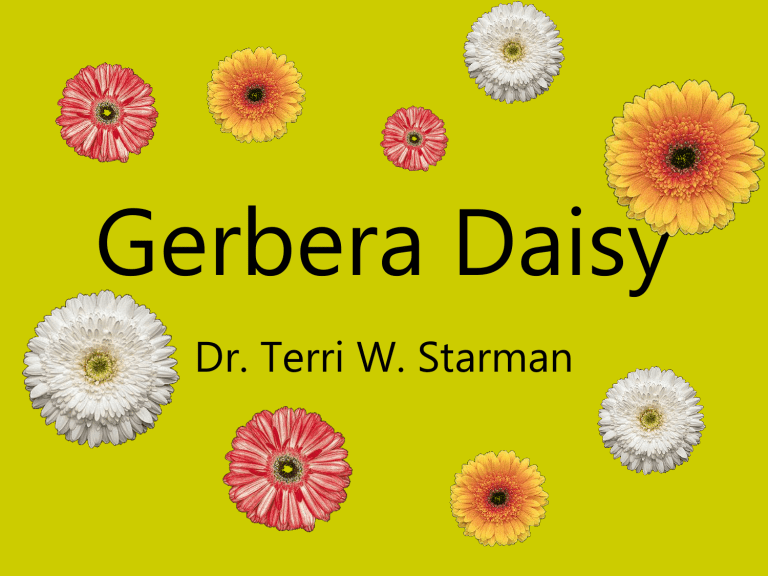
Gerbera Daisy
Dr. Terri W. Starman
History
Discovered by botanist Robert Jameson in 1878
Origin: South Africa
The Botanical gardens in Kew, England identified the plant and gave it the species name
Gerbera jamesonii
Most modern breeding has taken place in the Netherlands
History (con’t)
Produced in North America in the 1920’s
University of California’s breeding program made them suitable for garden use in the
1970’s
Florida/Europe developed them for cut flower greenhouse production
Majority of cut flowers come from:
Columbia, South America, the Netherlands
Gerbera Facts
Uses:
Cut flowers, potted plants and bedding plants
White, yellow, red, pink, orange, scarlet and bicolor flowers
Single composite inflorescences are on a nonbranching scape
Gerbera Facts (con’t)
20 inch diameter plants for cut flowers
28 inch scape length for cut flowers
1.75 to 5 inch diameter flower size
Flowering
• 11 to 16 weeks after transplanting
in vitro
propagated plugs
• First visible flower buds are observed after 10-14 leaves have developed in the primary leaf whorl
• FI and FD are mainly affected by light intensity and temperature
• FI after two to three true leaves are visible
Temperature
• Pot plants 70/63 °F day/night
• Most rapid development at 76 °F
• 70/75 °F day and 57/66 °F night is a compromise for cut and pot plants
• Plants respond to light intensity X duration
Water and Nutrition
• Never overwater
• Allow to dry slightly between irrigations
• 300 ppm N 30-10-30 once after transplanting when leaves have formed, thereafter no further phosphorus is needed
• Magnesium and iron deficiencies are common because of high requirement
• Mg SO
4 monthly at 16 oz/100 gal
• Fe chelate constantly at 0.5 oz/100 gal
Media
• Avoid pH > 6.5 and high soluble salts
• Frequent media monitoring is recommended
• Good drainage and aeration are essential
Height Control
• Flower scape length and plant diameter are inherent and cultivar selection is necessary for each use
• Greater DIF = longer scape
• B-nine reduces scape length, leaf size and darkens leaves
• B-Nine (4000 ppm) applied 8 weeks after transplanting
• Cycocel is not effective
Spacing and Disbudding
• Don’t let leaves overlap and don’t let the growing point get covered with anything
• Cut flower space 13 X 13 to 15 X 15
• Pot plants 1.4 to 3 plants per square foot
• 5-inch pot space at 11 X 11
• Removing first flower will allow more rapid and uniform elongation of remaining scapes
Scheduling and Timing
• Sales of 4-inch pots:
• 10 to 11 weeks after transplantation from April to September
• 14 to 16 weeks after transplantation from September to April
Insect Problems
Whitefly
Thrips
Aphids
Spider Mites
Cyclamen Mites
Fungus gnats
Leaf miners
Worms, slugs and snails http://hortipm.tamu.edu/pestprofiles/sucking/wfthrips/wfthrips.html
Diseases
• Botrytis (Decree, Chipco 20019)
• Powdery Mildew (Phyton 27)
• Phytophthora (Subdue)
• Rhizoctonia (Systec, Medallion)
• Pythium (Subdue)
Physiological Disorders
• Bent-neck is the insufficient flower stem hardening or maturation of the stem tissue below the harvested flower which results in stem collapse
Postharvest
• Both cut and pot are harvested when the two outer rows of disc florets are open and pollen can be seen
• Stems are pulled not cut
• Bent neck is related to bacterial contamination
• Only slightly sensitive to ethylene
Diagnosing Problems
If flower stems are too tall or foliage too large:
-Light intensity too low
If flowers are too short or hidden in foliage: Could be the use of excessive fertilizer
-Plants drying out too frequently
-Too much growth regulator
-Growing temperature too low
-Soluble salts too high
Diagnosing Problems
If flowers are distorted:
-Caused by mites or thrips
If plant is stunted or fails to grow:
-Poor drainage
-Packing soil too tightly
-Low soil temperatures
If plant wilts or dies:
-Planted too deep (crown rot/root rot)

